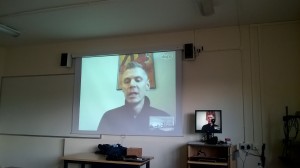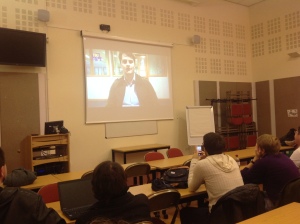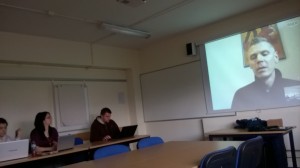By Dr. John FitzGibbon
I’ve been using Webinars for just over a year in my teaching here at CCCU and I think it is time to evaluate them as a form of teaching practice.
What you may ask, is a Webinar? Generally it is understood as an online ‘event’ hosted by a particular organisation and broadcast to a select group of users. This typically takes the form of a live video broadcast. Obviously given different disciplines there can be huge variety in content for this live video and this blog post will focus on how they can apply for Politics/International Relations and the Social Sciences more generally. But the potential wider educational impact of using Webinars is clear.

I have been using them in two main formats: 1. Hosted and organised by external partners, 2. Hosted and organised by myself. There have been mixed results with both approaches but overall the use of Webinars has been viewed positively by my students. Additionally, it has exposed both them and myself to new teaching methods and to the power of the internet as a learning tool. Much is made of the potential of the internet to enhance student learning but there is still the need to fit specific internet based usage into defined pedagogic strategies. This blog post aims to tease out some of the potential use of Webinars as part of a typical Social Sciences undergraduate module.
- External Partner Led Webinar
I have a great working relationship with the Global Net 21 NGO. Their goal is to link the community with politicians and other decision makers in a constructive narrative. What they bring is technology, contacts and experience. My students and I shot a series of videos (available here) on the issue of food scarcity. Global Net 21 were able to edit them altogether into a coherent whole. This takes both time and technical training which most educators simply don’t have, to make the videos look somewhat professional. As Global Net 21 have been hosting Webinars for many years, they have developed the technology to stream two live video feeds, with a comment box for invited guests on a single web-based platform. This allows for a diverse audience to participate remotely in the Webinar. But perhaps the most important element that an external partner brings is contacts. My students have been able to participate in Webinars with many MPs and former government minister Peter Hain MP. Ordinarily it is difficult to get MPs to commit time to a Webinar but they have been happy to give time to Global Net 21. An educator can face a struggle in getting even 30 minutes from a leading figure to participate with a class but an outside partner, particularly an NGO, brings cache. Moreover, a well-established external partner can allow the educator and students to interact with a wide variety of participants, enhancing the learning experience and facilitating networking with more potential partners.

The clear drawback in working with an external partner is that your pedagogical goals for the class might not always align with the outcomes the topics the partner wants to focus on. This means compromise which generally results in discussion that may not be closely related to the module. While an external partner with excellent technology skills and contacts can make a Webinar happen in the first place, the main cost is a lack of control. With Webinars this means a loss of interaction. The external partner hosts the event, asks the questions, refers or does not refer to you and generally guides the discussion where they want. This might lead to an overlap in interests but more often than not in my experience leads to students becoming bored by a discussion lacking the required academic rigour that does not include them.
- Educator Led Webinars
In response to this reduced level of interaction my students experienced in previous Webinars, I sought to organise my own. Lacking the equipment and time to work with an online interactive Webinar platform I decided to just use Skype and contact potential Webinar participants myself. Though there are many specific Webinar platforms available but they need to be bought and many universities have issues over downloading, installing and purchasing software that are more hassle than they are worth. Using this excellent Logitech conference cam there were no technical difficulties with Skype. Participants could hear us, even questions from the back of the class room and we could hear them. I invite individuals that I want the students to interact with meaning that there is no need for compromise on the themes to be discussed and the Webinar fitted in seamlessly with the module learning goals. For my most recent Webinar on 5th of February I circulated articles written by the individual, Philippe Legrain an expert on the European Financial Crisis, and asked the students to draft up questions for Philippe. In the previous week we had covered the role of finance in the global economy and the first hour of class was focused on the development of the Eurozone. I asked Philippe to participate as not only did he write an excellent book on the Eurocrisis but he has plentiful media experience and so can communicate his ideas succinctly. For the lesson plan I envisaged the second hour of class been given over for the Webinar, allocating Philippe 20 minutes to speak on the reasons why he thought the Eurocrisis happened, and then for a 20 minute question and answer session with students. Philippe spoke so well and with such completeness that he actually answered all the students questions. Students recorded his discussion on their phones and several bought his book on Amazon as he was speaking. The students were extremely positive on the experience. They were impressed to have such an authority, he had been on BBC Newsnight the week before, talk to them and answer all the questions on a deeply complex contemporary issue.

From this I took that an educator led Webinar is far more work than bringing in an external partner. However, it allows for a better pedagogical outcome. This is due to greater levels of control. Paramount in this is that the educator can chose the participant and frame the Webinar to directly encompass learning goals. With a good Webcam and internet connection there are no technical issues. The only significant problem is to locate a participant with the required skills, strong personality and time to be involved.
The Pedagogic Usefulness of Webinars
Concluding on the pedagogic usefulness of Webinars I have found them to be a potentially excellent tool for educators. An interesting finding from participating in 12 Webinars is how their informal nature lends itself to an excellent flow of discussion. This is in contrast to invited lectures where the guest gives a formal lecture involving a huge time commitment on both sides on a theme that though suggested by the educator, might deviate from the module content. A Webinar gives the opportunity to guide a guest on to themes that are directly relevant to the module and allow for students to interact more intimately with them in a less formal setting. Taking control of the process does require some degree of organisation in finding a suitable participant and finding a suitable time but they, and the accompanying technological issues, are not insurmountable. Using Webinars I have found brings new voices and insight into the classroom and facilitates student interaction with outside experts. It also encouraged me to interact with NGOs and other members of the community. The more advanced elements of Webinars, contextualizing video, require too much preparation time for an individual educator. Access to a dedicated and skilled Teaching and Learning Team would enable a much more advanced Webinar process like this to be developed but many do not have such help available. To educators I would advise to try a Webinar. Find a suitable participant, brief them on what topics you want them to discuss, give guidance to your students to prepare questions and let the debate flow!
 Politics
Politics Anna Vanaga
Anna Vanaga 691
691



2 comments on “Using Webinars in Political Science Education”